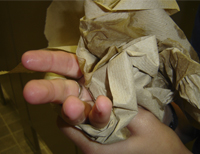Paper Towels Or Hot Air Dryers - Which Is Better
And Why?
|

|
|
|
We all know 80% of common infectious diseases are spread by our hands and effective hand washing remains our best defense - but what about hand drying?
|
|
A recent hygienic efficacy study of different hand drying methods, led by researches at Queensland University in Brisbane, Australia put this question to the test.
|
|
|
|
Hand drying after all is an essential part of the hand washing process, as the spread of bacteria is more likely to occur with wet skin than from dry skin.
|
|
Scientists reviewed twelve independent studies comparing paper towels, cloth towels, and hot air dryers. Hand drying effectiveness included, "the speed of drying, degree of dryness, effective removal of bacteria, and prevention of cross-contamination."
|
|
The study revealed, "from a hygiene viewpoint, paper towels are superior to electronic air dryers" and "drying hands thoroughly with single-use, disposable paper towels is the preferred method of hand drying." It concluded by recommending, "The provision of paper towels should be considered as a means of improving hand hygiene adherence."
|
|
When it came to drying efficiency for example, the results indicated that, "residual water was more efficiently removed from the hands by cloth or paper towels." In fact, with just 10 seconds of drying with a single serve towel, the residual water on the hands was reduced to just 4% and dropped to just 1% with 15 seconds of drying. Air dryers were much slower and required 45 seconds to reduce the residual water to 3%. The bottom line, paper towels can generally achieve 90% or more dryness with normal use.
|
|
The effectiveness in the removal of bacteria was measured by assessing the, "changes in the number of bacteria on the hands before and after the use of paper towels, hot air dryer, or jet air dryer. They found that paper towels, "reduced the numbers of all types of bacteria on the hands" and hot air dryers were the least effective method of removing bacteria from washed hands. Many studies have found that friction is the key component in hand drying as it helps to remove contamination. Micobiological testing of the paper towels after use, demonstrates that many bacteria are transferred from the hands to the paper towels."
|
|
Even more terrifying for all of us is the fact that every time a toilet is flushed, "a fine aerosol mist can be sprayed into the air. This mist may contain may types of fecal bacteria that can cause diseases. Air movement can encourage the dispersal and transmission of bacteria and increase the chance of cross-contamination. Used air dryers in washrooms are often contaminated and can emit bacteria in their air flow. So there is a potential risk of persons standing in front of air dryers acquiring the bacteria being dispersed into the air current towards them.” No such spread was seen with either paper or cloth towels.
|
|
Ultimately paper towels are the best option for settings where infection prevention is critical. Users have a strong preference for using paper towels and that "hand hygiene adherence would possibly decrease if paper towels are not available in washrooms."
|
|
Also, air dryers that are used in many washrooms allow for only one user at a time and each person could take up to one minute to dry their hands. This is not convenient and often leads to avoidance or incomplete drying. In several studies, on average people spent just 22.5 seconds drying hands, and 41% wiped their hands unhygienically on clothes.
|
|
In instances where paper towels are not available remember to always follow recommended hand washing technique, take extra time to dry your hands with an air dryers and consider carrying a personal size bottle of alcohol hand sanitizer as an added level of defense.
|
|
Article Source: https://info.debgroup.com/blog/bid/297155/paper-towels-or-hot-air-dryers-which-is-better-why
|
|
|
|

|
| One pint of donated blood can save up to 3 lives. |
| Someone in the U.S. needs blood every two seconds. |
| A newborn baby has about one cup of blood in his body. |
| There are 100,000 miles of blood vessels in an adult human body. |
| A red blood cell can make a complete circuit of your body in 30 seconds. |
Source:
https://www.factslides.com/s-Health
|
|